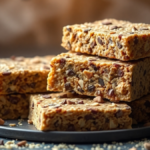A gluten belly refers to the bloating, discomfort, and swelling that occurs in the abdominal area after consuming gluten. Gluten is a protein found in wheat, barley, rye, and other grains, and it is a common ingredient in many foods like bread, pasta, and pastries. The symptoms of a gluten belly are often mistaken for other digestive issues, but they are specifically related to the body’s inability to properly digest or tolerate gluten.
When someone with a gluten sensitivity or intolerance consumes gluten, it can trigger an immune response that leads to inflammation in the gut. This inflammation can cause the stomach to bloat, leading to feelings of fullness, discomfort, and sometimes pain. Over time, repeated gluten consumption in individuals with this sensitivity can result in chronic digestive issues and even contribute to more serious conditions like celiac disease.
It’s important to note that a gluten belly doesn’t necessarily indicate an allergy. Rather, it signals an intolerance or sensitivity to gluten, which affects the digestive system in different ways for different people.
Understanding the Symptoms of a Gluten Belly
The symptoms of a gluten belly can vary from mild to severe, but the most common signs include bloating, abdominal pain, and excessive gas. These symptoms usually occur shortly after eating foods that contain gluten. For those experiencing gluten intolerance or sensitivity, these symptoms are often recurring, especially when gluten is consumed regularly.
Here are some key symptoms of a gluten belly:
- Bloating: A feeling of fullness or puffiness in the stomach area after consuming gluten-containing foods.
- Abdominal Pain: Cramping, discomfort, or sharp pain in the abdomen, often accompanied by bloating.
- Gas: Increased gas production in the gut, leading to discomfort and sometimes embarrassing situations.
- Diarrhea or Constipation: Some people with a gluten belly may experience changes in bowel movements, including diarrhea or constipation.
- Fatigue: As the digestive system struggles to process gluten, many individuals report feeling unusually tired or sluggish.
While these symptoms can be uncomfortable, they are often manageable with dietary adjustments and proper treatment. However, it’s essential to consult a healthcare professional for a proper diagnosis if these symptoms persist.
How to Manage and Prevent a Gluten Belly
Managing and preventing a gluten belly involves making dietary and lifestyle changes to avoid gluten-triggered symptoms. For individuals with gluten sensitivity or intolerance, the most effective way to prevent these uncomfortable symptoms is by adopting a gluten-free diet.
Here are a few strategies to manage and prevent a gluten belly:
- Eliminate Gluten from Your Diet: The most straightforward way to manage a gluten belly is to avoid gluten-containing foods altogether. This includes bread, pasta, baked goods, and most processed foods that contain wheat or other gluten-rich grains.
- Check Food Labels: Many packaged foods contain hidden sources of gluten, so it’s essential to read labels carefully. Look for terms like wheat flour, barley, or rye to avoid unwanted gluten exposure.
- Introduce Gluten-Free Alternatives: There are plenty of delicious gluten-free options available today. Quinoa, rice, and gluten-free pasta can replace traditional grains and pasta while still providing a satisfying meal.
- Support Digestive Health: Probiotics and enzymes can help support digestive health and ease symptoms. Speaking with a healthcare provider about supplements can be a great step for managing gut discomfort.
- Stay Hydrated: Drinking plenty of water throughout the day can help flush out toxins and ease bloating caused by gluten sensitivity.
With consistency and discipline in adhering to a gluten-free lifestyle, individuals can effectively manage a gluten belly and prevent it from impacting their daily life.
What Causes a Gluten Belly? Key Factors to Know
The causes of a gluten belly are largely related to the body’s inability to digest or tolerate gluten. While there are various factors that can contribute to gluten sensitivity or intolerance, the primary causes are either genetic or environmental.
- Genetic Factors: Some individuals are genetically predisposed to developing gluten intolerance. Those with a family history of celiac disease or gluten sensitivity are at a higher risk of experiencing a gluten belly.
- Leaky Gut Syndrome: This condition, in which the lining of the intestines becomes damaged and permeable, is thought to play a significant role in the development of gluten sensitivity. When the gut lining is compromised, gluten particles may leak into the bloodstream, triggering an immune response and inflammation.
- Immune System Response: In some individuals, the immune system sees gluten as a foreign invader, even though it is harmless. This reaction can lead to inflammation in the digestive system, contributing to the symptoms of a gluten belly.
- Overconsumption of Gluten: In some cases, frequent consumption of gluten may exacerbate sensitivity, even in individuals who have not previously experienced symptoms. Eating large quantities of gluten on a regular basis can overwhelm the digestive system and cause inflammation in the gut.
In addition to these factors, environmental triggers such as stress, infections, and an imbalanced diet can also contribute to the development of a gluten belly.
Gluten Belly vs. Gluten Sensitivity: What’s the Difference?
While a gluten belly is a common symptom of gluten intolerance, it’s essential to differentiate between the two. Gluten sensitivity, also known as non-celiac gluten sensitivity, refers to a group of symptoms that occur after eating gluten, but it is not linked to any identifiable autoimmune disease like celiac disease.
Here’s how a gluten belly and gluten sensitivity compare:
- Gluten Belly: This term typically describes the bloating, discomfort, and other digestive issues that arise after consuming gluten. It is a sign of gluten intolerance and is characterized by abdominal symptoms such as bloating, pain, and gas.
- Gluten Sensitivity: Gluten sensitivity, on the other hand, is a broader term. It encompasses all the symptoms that arise from gluten intolerance, including a gluten belly. However, it can also include symptoms such as headaches, fatigue, joint pain, and mood swings, which are not necessarily linked to digestive discomfort alone.
The key distinction lies in the cause and broader impact on health. Gluten belly focuses specifically on abdominal symptoms, while gluten sensitivity can manifest in a range of symptoms throughout the body.
By understanding the difference between these two conditions, individuals can better identify the root causes of their discomfort and make more informed decisions about managing their diet.
Loaded Brown Rice Pasta: A Satisfying Option for Plant-Based Diets
Loaded brown rice pasta is an ideal meal choice for those following plant-based diets, providing a hearty and nutrient-rich alternative to traditional pasta. Made from whole-grain brown rice, this gluten-free option is packed with fiber, vitamins, and minerals, making it both satisfying and nutritious. Since it is a plant-based dish, it’s naturally free from animal products and works well for those who are vegan or vegetarian.
One of the great advantages of loaded brown rice pasta is its versatility. It can easily be combined with a variety of plant-based ingredients, such as vegetables, legumes, nuts, and seeds, to create a balanced and filling meal. For example, you could toss it with roasted vegetables, vegan protein sources like tofu or chickpeas, and a plant-based sauce to create a delicious and complete meal.
Not only is this pasta a healthy choice, but it also caters to people with dietary restrictions, making it a perfect fit for anyone looking to enjoy a plant-based lifestyle without sacrificing taste or satisfaction.
How to Customize Your Loaded Brown Rice Pasta to Suit Your Taste
One of the best things about loaded brown rice pasta is how easily it can be customized to suit your unique taste preferences. Whether you prefer spicy, creamy, or tangy flavors, this dish can be tailored to meet any craving. The key to customizing your pasta is choosing the right combination of vegetables, sauces, and seasonings that complement the hearty texture of brown rice pasta.
For a spicy variation, consider adding red pepper flakes, jalapeños, or a spicy tomato sauce. If you’re in the mood for a creamy dish, try making a cashew-based cream sauce or blending avocado with olive oil and lemon juice for a smooth, rich dressing. To satisfy those who prefer more savory and umami flavors, roasted vegetables like mushrooms, eggplant, and bell peppers work well to bring depth to the dish.
In addition to varying the sauce and vegetables, you can also adjust the proteins and garnishes. Try adding plant-based proteins like tempeh, lentils, or beans for added texture and nutritional value. This flexibility allows you to create a loaded brown rice pasta meal that perfectly aligns with your flavor preferences.
Loaded Brown Rice Pasta: The Ultimate Comfort Food with a Healthy Twist
Loaded brown rice pasta offers all the comforting qualities of traditional pasta dishes but with a healthy twist. Instead of refined white pasta, which is often low in fiber and nutrients, brown rice pasta retains its bran and germ, providing more fiber, protein, and essential nutrients. This makes it a better choice for those looking to maintain energy levels and promote digestive health.
What sets loaded brown rice pasta apart from classic comfort food is its ability to absorb and complement a wide range of sauces, whether creamy, tomato-based, or olive-oil-based. When paired with nutrient-rich vegetables, lean plant proteins, and healthy fats, it transforms from a simple carb-based dish into a well-rounded, hearty meal.
For the ultimate comfort food experience, consider loading your brown rice pasta with sautéed greens like spinach, roasted vegetables, and a savory vegan cheese sauce. This hearty combination satisfies cravings while also providing the health benefits of a plant-based diet.
Creative Variations of Loaded Brown Rice Pasta You Need to Try
Loaded brown rice pasta is incredibly versatile and can be made into countless creative variations to suit any taste. Whether you prefer fresh, seasonal ingredients or bold flavors, you can easily transform this pasta into a dish that reflects your personal preferences.
- Mediterranean-Inspired Loaded Brown Rice Pasta – Toss the pasta with cherry tomatoes, olives, artichoke hearts, and a tangy olive oil dressing for a Mediterranean flair. Add some chickpeas for a protein boost.
- Vegan Alfredo Loaded Brown Rice Pasta – Create a creamy Alfredo sauce using cashews, nutritional yeast, and garlic. This plant-based version gives you the rich, comforting taste of Alfredo without the dairy.
- Pesto Loaded Brown Rice Pasta – Blend fresh basil, garlic, pine nuts, and olive oil to make a vegan pesto sauce. Combine with roasted vegetables like zucchini and eggplant for a flavorful, plant-based meal.
- Spicy Peanut Loaded Brown Rice Pasta – For a spicy, Asian-inspired dish, make a peanut sauce with peanut butter, soy sauce, lime juice, and sriracha. Toss with your pasta and top with fresh cilantro and crushed peanuts.
These creative variations show just how adaptable loaded brown rice pasta can be. With the right combination of flavors, you can keep this dish exciting and fresh every time.
How to Make Loaded Brown Rice Pasta a Regular Part of Your Diet
Incorporating loaded brown rice pasta into your regular diet is a great way to enjoy healthy, filling meals that are easy to prepare. Whether you’re looking for a quick lunch, a satisfying dinner, or a meal prep option, this dish can be adapted to suit your needs. The first step in making it a regular part of your diet is to stock your kitchen with the necessary ingredients.
Start by purchasing brown rice pasta in bulk and storing it in your pantry. This gluten-free pasta is a great alternative to traditional pasta and can be used in a variety of meals. Next, keep a variety of fresh vegetables on hand—think spinach, bell peppers, mushrooms, and tomatoes—to add flavor and nutrients to your pasta. For added protein, stock up on plant-based protein options like lentils, tofu, tempeh, or beans.
To make loaded brown rice pasta a regular meal, plan your meals in advance. Prepare large batches and store them in containers for easy lunches or dinners throughout the week. You can also freeze individual servings for quick and convenient meals when you’re short on time. By keeping this dish simple, healthy, and adaptable, you’ll be able to enjoy it as a go-to option for many meals.
Conclusion
A gluten belly is a common and often misunderstood condition that affects many individuals with gluten intolerance or sensitivity. By recognizing the symptoms and understanding the causes, people can take steps to manage and alleviate the discomfort associated with gluten consumption. A gluten-free lifestyle, along with mindful eating habits and supportive digestive health practices, can help mitigate the effects of a gluten belly and improve overall well-being.
If you suspect you have a gluten belly, it’s important to consult with a healthcare professional for a proper diagnosis and to discuss the best course of action for your health. With the right approach, you can lead a symptom-free, healthy lifestyle while enjoying a variety of gluten-free foods.





